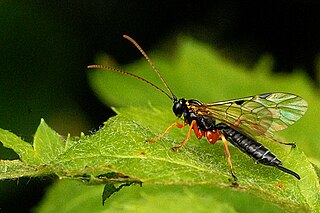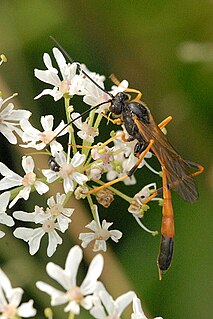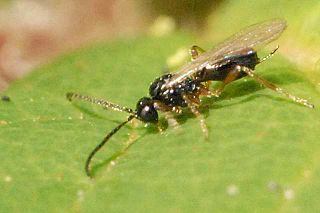The supposed American Elm cultivar Ulmus americana 'Pyramidata' was a Belgian clone listed by Wesmael in Bulletin de la Fédération des sociétés d'horticulture de Belgique, 1862, as Ulmus Americana pyramidalisHort.. It was marketed by the Baudriller nursery, Angers, France, and appeared in their catalogue of 1880 as U. Americana pyramidata. Wesmael's Ulmus americana and Ulmus americana var. variegata, however, do not appear from herbarium specimens to have been American white elm. It is known that nurseries in Europe and America marketed the golden wych elm Ulmus glabra 'Lutescens' as Ulmus americana aurea, so it is possible that Wesmael's Ulmus americana pyramidalis was similarly misnamed.
Himantopterus is a genus of moths in the family Himantopteridae. It was described by Constantin Wesmael in 1836.

Pimplinae are a worldwide subfamily of the parasitic wasp family Ichneumonidae.

Anomaloninae is a subfamily of parasitoid wasps in the family Ichneumonidae. Several species provide beneficial services to humans by attacking forest or orchard pests.

Ichneumoninae is a worldwide subfamily of the parasitic wasp family Ichneumonidae.
In this checklist are presented all wasp species of family Ichneumonidae.

The Cheloninae are a cosmopolitan subfamily of braconid parasitoid wasps.

The Helosciomyzidae are a small family of flies - 9 genera and 22 species. All are known from the Southern Hemisphere. With the exception of the South American genus Sciogriphoneura, the family occurs in Australia, New Zealand. Little is known of their biology.
Cotesia urabae is a small wasp, having a black body with yellow-brown legs, characterized by a solitary larval endoparasitoid stage. It is part of a large complex of 11 primary parasitoids of Uraba lugens Walker, many of which are polyphagous. The female inserts its ovipositor into the a U. lugens larva, depositing its eggs there, and it has been found that one female may carry up to 400 eggs. While C. urabae females are able to attack the same larva several times; only one single parasitoid completes its development in each larva.
The Field Elm cultivar Ulmus minor 'Viminalis Incisa' was listed and described by John Frederick Wood, F.H.S., in The Midland Florist and Suburban Horticulturist (1851), along with what he called U. Viminalis and U. Viminalis Variegata, as U. Viminalis Incisa, the Cut-leaved Twiggy-branched elm. An Ulmus campestris var. nuda subvar. incisaHort.Vilv. was described by Wesmael in 1863, and considered by Green (1964) to be possibly one of Melville's U. × viminalis.
Himantopterus caudata is a moth in the family Himantopteridae. It was described by Frederic Moore in 1879. It is found in Myanmar and Assam, India.
Himantopterus dohertyi is a moth in the family Himantopteridae. It was described by Henry John Elwes in 1890. It is found in India.
Himantopterus nox is a moth in the family Himantopteridae. It was described by Hering in 1937. It is found in India (Assam).
Himantopterus venatus is a moth in the family Himantopteridae. It was described by Strand in 1914. It is found on Java.
Himantopterus zaida is a moth in the family Himantopteridae. It was described by Edward Doubleday in 1843. It is found in northern India.
Himantopterus nobuyukii is a moth in the family Himantopteridae. It was described by Yasunori Kishida and Toshio Inomata in 1993. It is found on Borneo.

The Rogadinae are a large subfamily of braconid parasitoid wasps. Several Rogadinae species parasitize pest caterpillars and are important for naturally occurring biological control.

Blacini is a tribe of braconid Parasitoid wasps. Formerly the subfamily Blacinae, this group was demoted to a tribe and placed within the Brachistinae based on molecular evidence in 2011.

Brachistinae is a subfamily of braconid wasps in the family Braconidae.

Magadi Puttarudriah was an Indian entomologist who worked in the Government of Mysore and after 1957 in the Government of Karnataka. He was the first professor of entomology at the University of Agricultural Sciences, Bangalore created in 1964.








